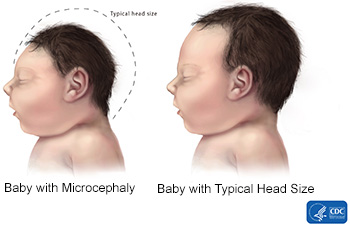Public Health Handouts for Families with Babies with Microencephaly
Att. 11 - Public Health Handsouts for Families with Babies with Microcephaly.docx
Zika Outcomes and Development of Infants and Children (ZODIAC) Investigation
Public Health Handouts for Families with Babies with Microencephaly
OMB: 0920-1194
ATTACHMENT 11
Public Health Handouts for Families With Babies With Microcephaly
 Microcephaly
is a birth defect where a baby’s head is smaller than expected
when compared to babies of the same sex and age. Babies with
microcephaly often have smaller brains that might not have developed
properly.
Microcephaly
is a birth defect where a baby’s head is smaller than expected
when compared to babies of the same sex and age. Babies with
microcephaly often have smaller brains that might not have developed
properly.
What is microcephaly?
Microcephaly is condition where a baby’s head is much smaller than expected. During pregnancy, a baby’s head grows because the baby’s brain grows. Microcephaly can occur because a baby’s brain has not developed properly during pregnancy or has stopped growing after birth, which results in a smaller head size. Microcephaly can be an isolated condition, meaning that it can occur with no other major birth defects, or it can occur in combination with other major birth defects.
Other Problems
Babies with microcephaly can have a range of other problems, depending on how severe their microcephaly is. Microcephaly has been linked with the following problems:
Seizures
Developmental delay, such as problems with speech or other developmental milestones (http://www.cdc.gov/ncbddd/actearly/milestones/index.html) (like sitting, standing, and walking)
Intellectual disability (decreased ability to learn and function in daily life)
P
 roblems
with movement and balance
roblems
with movement and balanceFeeding problems, such as difficulty swallowing
Hearing loss
Vision problems
These problems can range from mild to severe and are often lifelong. In some cases, these problems can be life-threatening. Because it is difficult to predict at birth what problems a baby will have from microcephaly, babies with microcephaly often need close follow-up through regular check-ups with a healthcare provider to monitor their growth and development.
Occurrence
Microcephaly is not a common condition. State birth defects tracking systems have estimated that microcephaly ranges from 2 babies per 10,000 live births to about 12 babies per 10,000 live births in the Unites States.1
Zika Virus and Pregnancy
For information about the effects of Zika virus infection during pregnancy, visit CDC's Zika and Pregnancy web page(http://www.cdc.gov/zika/pregnancy/index.html).
Causes and Risk Factors
The causes of microcephaly in most babies are unknown. Some babies have microcephaly because of changes in their genes(http://www.cdc.gov/ncbddd/genetics/basics.html). Other causes of microcephaly can include the following exposures during pregnancy:
Certain infections, such as rubella(http://www.cdc.gov/rubella/index.html), toxoplasmosis(http://www.cdc.gov/parasites/toxoplasmosis/gen_info/pregnant.html), or cytomegalovirus(http://www.cdc.gov/cmv/congenital-infection.html)
Severe malnutrition, meaning a lack of nutrients or not getting enough food
Exposure to harmful substances, such as alcohol, certain drugs, or toxic chemicals
Researchers are also studying the possible link between Zika virus infection(http://www.cdc.gov/zika/index.html) and microcephaly.
CDC continues to study birth defects, such as microcephaly, and how to prevent them. If you are pregnant or thinking about becoming pregnant, talk with your doctor about ways to increase your chances of having a healthy baby.
Diagnosis
Microcephaly can be diagnosed during pregnancy or after the baby is born.
During Pregnancy
During pregnancy, microcephaly can sometimes be diagnosed during an ultrasound (which creates pictures of the body). To see microcephaly during pregnancy, the ultrasound test should be done late in the 2nd trimester or early in the third trimester. For more information about screening and confirmatory tests during pregnancy, visit CDC’s birth defects diagnosis web page(http://www.cdc.gov/ncbddd/birthdefects/diagnosis.html).
After the Baby is Born
To diagnose microcephaly after birth, a healthcare provider will measure the distance around a newborn baby’s head, also called the head circumference, during a physical exam. The provider then compares this measurement to population standards by sex and age. Head circumference charts for newborns, infants, and children up to age 20 years in the United States can be found on CDC’s growth charts website. CDC recommends that health care providers use the WHO growth charts to monitor growth for infants and children ages 0 to 2 years of age in the U.S.
Often, healthcare providers should take the head circumference measurement when the newborn baby is at least 24 hours old. This helps make sure that compression due to delivery through the birth canal has resolved. If the healthcare provider suspects the baby has microcephaly, he or she can request one or more tests to help confirm the diagnosis. For example, special tests like a CT scan or an MRI can provide critical information on the structure of the baby’s brain that can help determine if the newborn baby had an infection during pregnancy. They also can help the healthcare provider look for other problems that might be present.
Treatments
Microcephaly is a lifelong condition. There is no known cure or standard treatment for microcephaly. Because microcephaly can range from mild to severe, treatment options can range as well. Babies with mild microcephaly often don’t experience any other problems besides small head size. These babies will need routine check-ups to monitor their growth and development.
For more severe microcephaly, babies will need care and treatment focused on managing their other health problems (mentioned above). Developmental services early in life will often help babies with microcephaly to improve and maximize their physical and intellectual abilities. These services, known as early intervention, can include speech, occupational, and physical therapies. Sometimes medications also are needed to treat seizures or other symptoms.
National Birth Defects Prevention Network. Major birth defects data from population-based birth defects surveillance programs in the United States, 2006-2010. Birth Defects Research (Part A): Clinical and Molecular Teratology. 2013;97:S1-S172.
| File Type | application/vnd.openxmlformats-officedocument.wordprocessingml.document |
| Author | Kotzky, Kim (CDC/ONDIEH/NCBDDD) (CTR) |
| File Modified | 0000-00-00 |
| File Created | 2021-01-22 |
© 2025 OMB.report | Privacy Policy